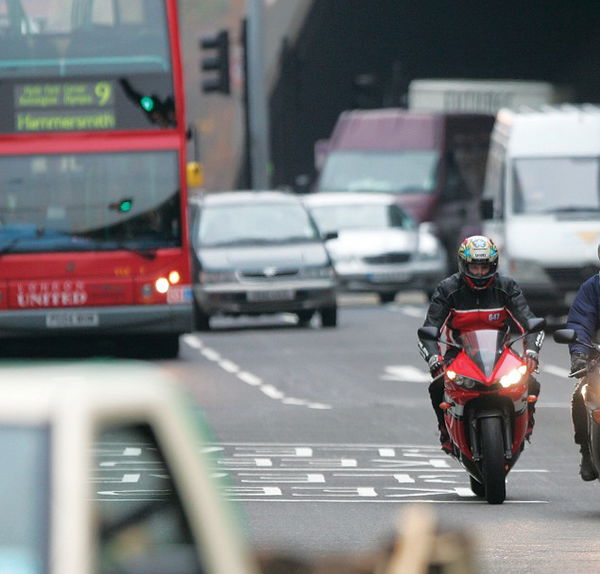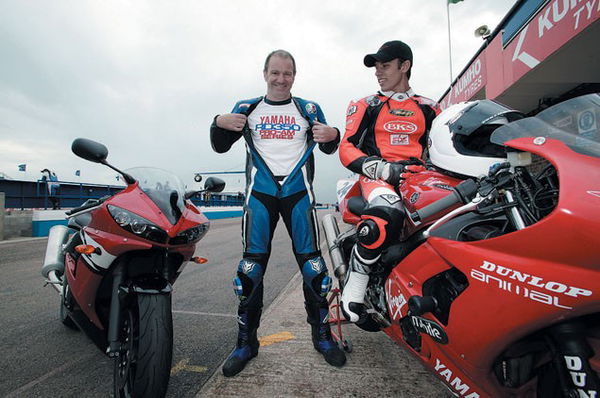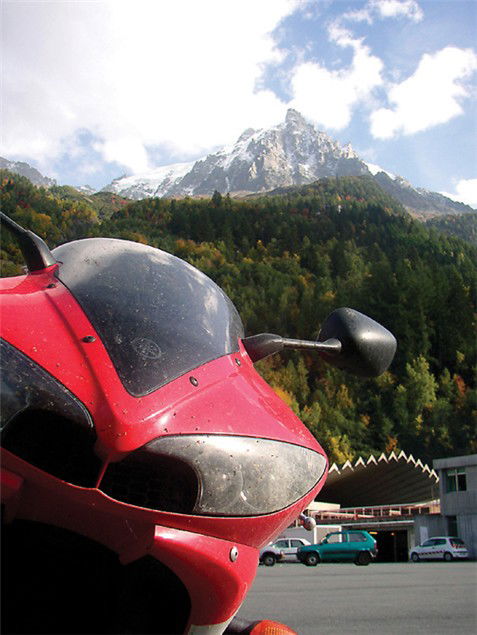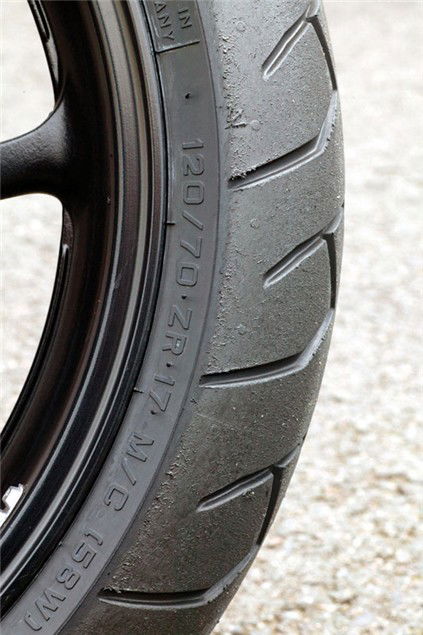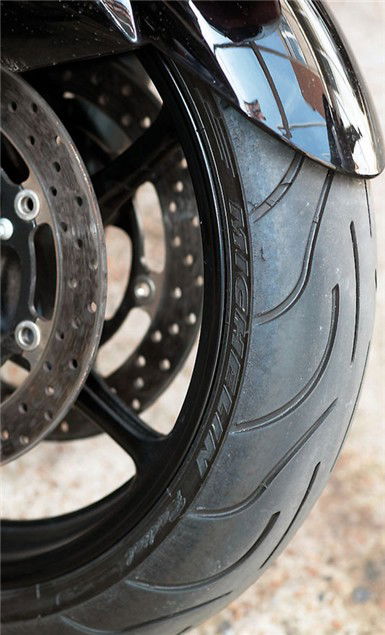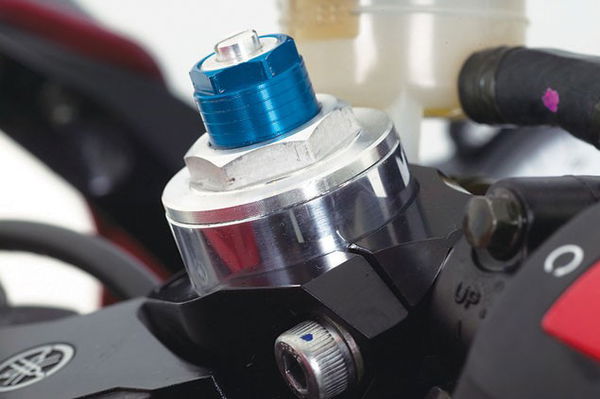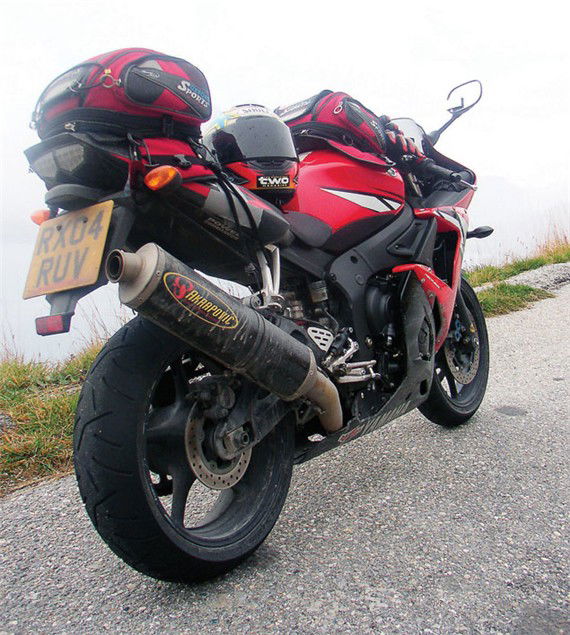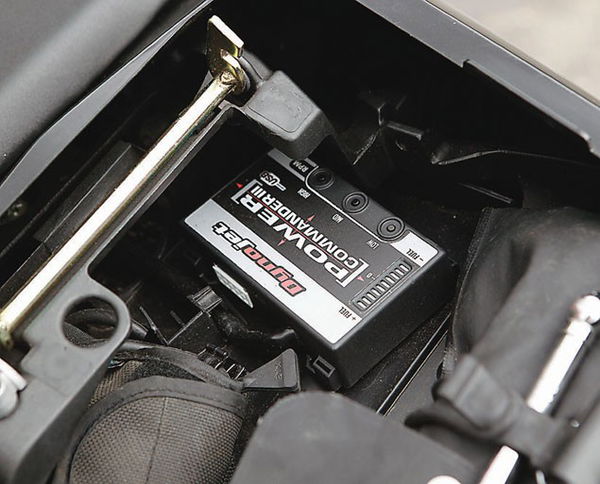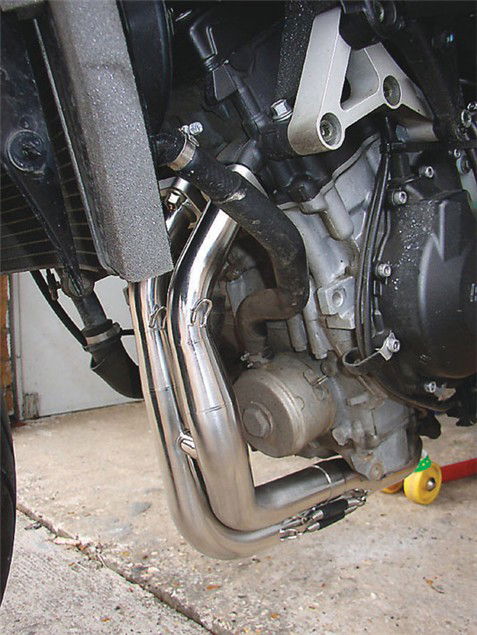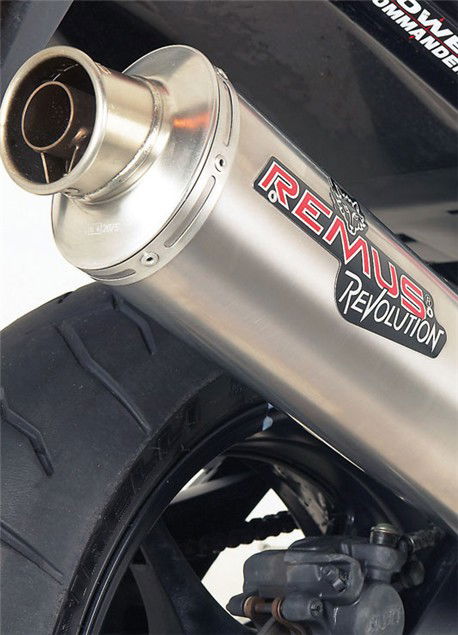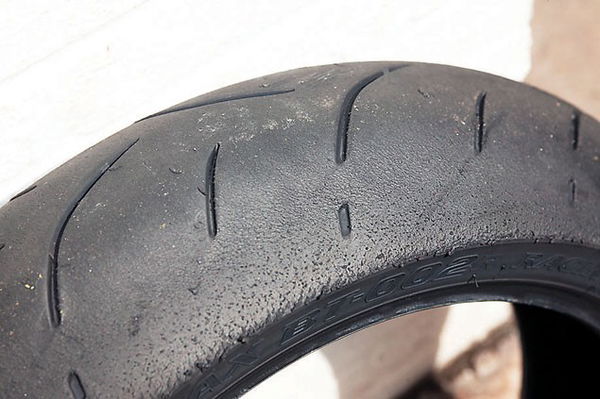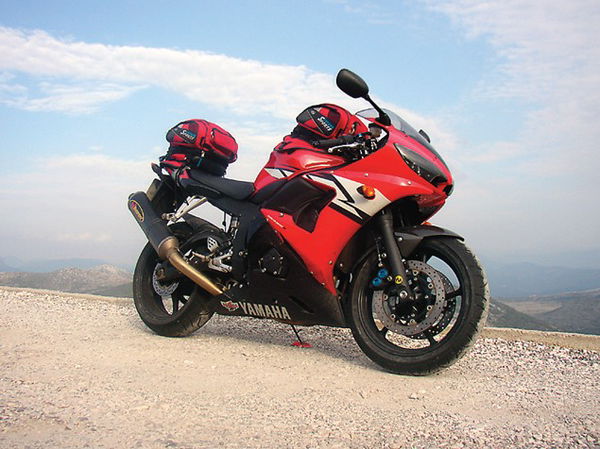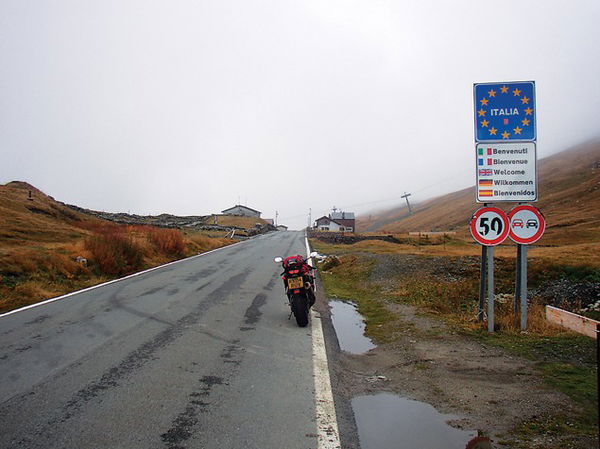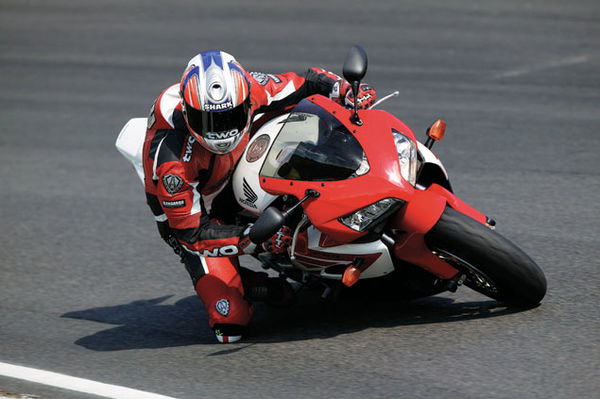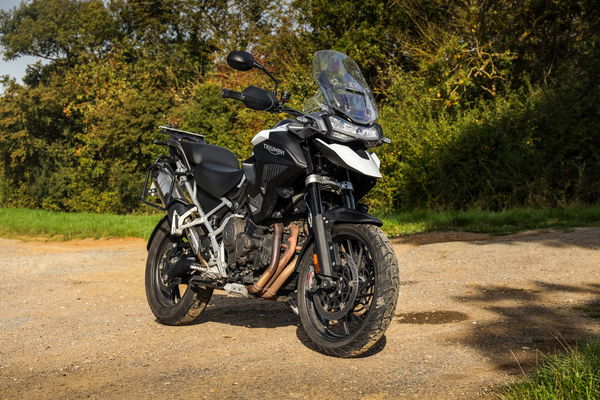Living with a 2004 Yamaha YZF-R6
Tim proves that the Yamaha R6 can handle the tracks, the commute and life as a tourer

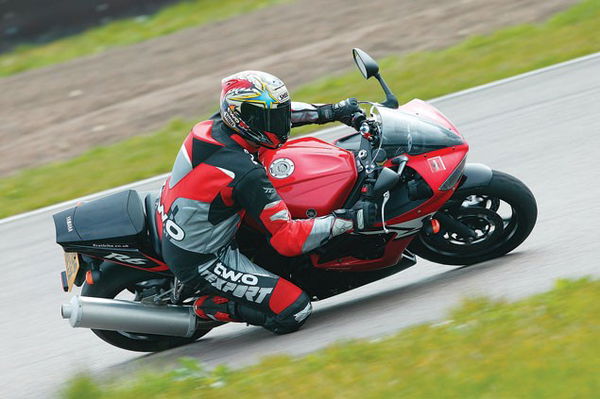
August 2004
Tyres this month. I've swapped the standard D208s for Pirelli Diablos, primarily to see what difference a 120/70 front (120/60 is standard) made to the R6's handling. Why Diablos?
Pirelli (along with Metzeler) are alone in listing 120/70 fronts as a recommended R6 fitment. The main issue with a 70-section is clearance under the front mudguard. Most 70-sections appear to fit, but all tyres grow at speed due to centrifugal forces. However, Pirelli's 0° steel belt construction minimises growth to just a couple of millimetres, so there are no clearance issues.
But it's not simply a case of swapping sizes. That '120/70' refers to the tyre's width in millimetres (120) followed by its height on the rim as a percentage of its width (70% of 120mm). A 120/60 is 72mm high and a 120/70 is 84mm high, so fitting the 70-section lifts the front of the bike by about 12mm (the precise amount differs from tyre to tyre).
This changes the geometry, slowing the steering and making the bike reluctant to hold a line in fast corners. The solution is to drop the yokes down the forks by 10mm or so to compensate. The difference is amazing. With some other twiddling, it's now the best handling R6 I've ridden. Crucially, the 70-section's profile improves turn-in and feedback at big lean angles. Urry reckons the same, and it makes us wonder still more why Yamaha doesn't supply the bike like this.
I was also keen to see how the R6 behaved on a different make of tyre. Waiting thousands of miles for rubber to wear out blurs the differences, as anything is an improvement after a knackered pair. For the record, I did 2158 miles on the excellent Diablos, including two track days, a dozen dyno runs and lots of tedious commuting - the harsh reality of my everyday riding.
The rear tread was down to 4mm from 5.7mm, which would give a life of around 5500 miles to the 'minimum of 1mm tread over the whole of the original tread pattern' required for legality. The front was down from 3.9mm to 3.
Anyway, they've been replaced with Michelin's new Pilot Powers, again with a 120/70 front, although Michelin doesn't list it as a fitment. The front profile is noticeably different - slightly taller and more triangular, reducing mudguard clearance to less than 5mm.
I reckon the tyre may have kissed the front edge of the mudguard, but couldn't be sure, so it was marginal if at all. I've tilted the mudguard back to increase clearance to nearly 7mm, but tyres grow more the faster you go, so I want to do a top speed run at Bruntingthorpe to make sure it doesn't foul the mudguard when flat out.
Other than that, the Pilot Powers really impressed. A Donington Park track day proved they had more grip than the Diablos, which is to be expected as they're pitched more to the stickier Diablo Corsa end of the market. Their more pointy profile makes them drop into corners very quickly and they're less forgiving to ham-fisted input. They're also more sensitive to white lines than the Pirellis, but the rewards are worth it. I doubt if they'll last as long though.
We'll see...
October 2004
The R6 comes with pretty decent standard suspension. The main problems are too-soft forks with a lack of rebound damping, and a slightly too-stiff spring in the rear for your average weight rider.
There's only so much you can do with the standard adjusters, but it's possible to redress some of the imbalance. I've wound up the front preload to stop the forks collapsing under the weight of me and the bike, and increased rebound damping to control their return from full compression. And remember, I've dropped the yokes down the forks too (see last month).
At the back, rear preload is standard for the track - position four out of nine - with a couple of clicks more rebound and compression. The rear shock works pretty well, especially for my weight (15 stone plus leathers). Lighter riders may want to back off the preload, but this will slow the steering down, otherwise the only answer is a softer spring. The settings I've settled on work superbly on track, although the rear is a bit harsh on the road, so I back off everything a click or two for everyday riding.
So that's what I've come up with. But I thought it would be a bit of fun to test the theory against some serious opposition, so we enlisted the help of Virgin Mobile R6 Cup star Richard Wren and met up for a Track Attack track day (01332 819503) at Donington Park. To make sure Richard got something extra out of the day we also brought Niall Mackenzie along to give him the benefit of his experience.
Richard has really started to shine in the R6 Cup and has emerged as a real star and genuine contender for the championship and next year's BSB ride in the Virgin Mobile squad. When we met up at Donington he was second in the championship. Two weeks later he won at Thruxton, and two weeks after that he won again at Brands, taking the title lead in the process. At the time of writing Richard was a cool 38 points clear of second-placed James Hillier at the head of the championship.
"I was hoping to be winning races from the beginning," he admits. "My results now are a mixture of everything really; knowing the tyres and knowing the bike. My confidence overall has been building and it's all come together."
Comparing my bike to Richard's was an eye-opener - I didn't know the R6 Cup bikes were so standard. Everything about the series ensures an absolutely level playing field. Surplus road bits are removed, an Akrapovic end can is fitted and riser plates lift the standard footrests up and back.
The standard 15-tooth front sprocket is changed for a 14-toother (no gearing changes allowed from track to track), OE Dunlop D208s are swapped with stickier D208RRs (one front per meeting, a new rear for the race), SBS track compound brake pads are used and a steering damper, crash bungs and a double-bubble screen are fitted. That's your lot - even the standard rubber brake hoses remain.
On the day, Richard's bike was set up a bit differently from mine, with rear preload jacked up and front preload backed off to get the bike standing on its nose and turning on a sixpence. However, he has since admitted to going "backwards and forwards" with the settings. "I started off raising the bike and stiffening it up then I've gradually softened it up. The forks have been pulled through by 5mm, which is standard on all the race bikes because of the taller profile of the D208s. I spoke to a lot of people about the settings and have been told to keep the bike pretty much flat, so I'm now back to standard factory settings."
Riding out on track with Niall, Richard reckoned his bike had a bit more drive off the turns - probably down to his one-tooth lower gearing and the Akrapovic can (and the drag caused by my bike's mirrors and indicators). Otherwise, they were pretty evenly matched, with Niall's bottomless pit of experience giving him an edge over Richard's youthful exuberance.
So what have we learned from all this? Not sure really. One thing's certain - Richard Wren is a bit handy and a real star in the making. He certainly impressed Niall: "Before the day at Donington, I didn't know what level the R6 Cup guys were at. I suspected the first half-dozen or so were pretty capable, but I was surprised how accurate Richard was lap after lap. And I was impressed by his maturity. We went out on track without making much of a plan, but he took the opportunity to learn from it. If I was in his position I'd have flown past and shown what I could do, but Richard sat behind me until I waved him past.
"I don't know how much it helped him, maybe it got his confidence up a bit. It's a real step-by-step process and every little helps. He's intelligent, he's fit, strong and the right build for riding a four-stroke. I've obviously been watching him more closely since and he's done exceptionally well at two very different tracks. At Brands he didn't get away so well but he didn't panic. He read the race well, knew what he could do and got the win."
We also learned that Niall can still show the kids the way round, and R6s are pretty effective tools even in near stock form. I think we knew most of that already, but it was fun making sure.
January 2005
The R6's standard exhaust does the best it can but strangles the motor above 12,500rpm. Power drops off sharply after that, and there's little to be gained revving beyond 13,000 - that's 2500rpm going to waste.
To help it work as nature intended, I tried a couple of options: a Remus can with removable baffle and a full Akrapovic system, then threw in a Dynojet Power Commander.
Both the Remus and Akrapovic come with removable baffles and conform to current European noise regs in their muted state. Both make a significantly different noise to standard, like a quiet version of a loud pipe. The baffled Akrapovic also sails through Donington Park's strictly enforced 98dB quiet track day noise limit.
The Remus is well made, well finished and takes about three minutes to fit. With the baffle in place, the R6 made a tiny fraction less power across the entire range, otherwise accurately mirroring the standard curve. On the road, the difference is barely noticeable because the shape of the curve is the same as standard. Looks and sounds better than standard, by no means loud, just a different tone. And it's lighter.
Baffle out the Remus makes the same power up to 12,500rpm, where the standard-piped motor tails off. The Remus lets the R6 rev higher and adds another 3bhp at peak, but what's most noticeable is how it hangs on to the revs above that. That and the noise. It's loud.
Next, Akrapovic. First, a nod to its build quality, finish and ease of fitting - it took longer to remove the R6's fairing than it did unbolt the old pipe and fit the Akrapovic. Secondly, it works. More torque everywhere and no losses, with significant improvements between 6 and 9000rpm and a nice flat torque peak from 10-12,400rpm. Above that it holds onto the revs for much longer and it's now worth hanging on to a gear all the way to the 15,500rpm redline. Peak power is only 4bhp up on standard, but that doesn't do justice to the gains across the whole range. It's like the motor has given its nose a really good blow and can now breathe more easily.
Finally, a Dynojet Power Commander III fuel injection tweaker was added, and set up by HM Racing in Orpington. Ready-made downloadable maps are available for most combinations of bike and exhaust, but a custom map is the way to go. The graph tells most of the story - more of everything, everywhere, with another 6bhp at the top over the Akrapovic on its own - but what it doesn't show is the improved response every single time the throttle is touched. It's like all of the engine's components have been lightened; the motor feels fresher, crisper and livelier. And that's at all rpm. While Power Commanders are billed as a performance add-on, the difference it makes to everyday riding is remarkable. The R6 now fuels so well it'll pull wide open throttle from 30mph in top. And this is with the baffle still in place. And that's the way it's staying.
The pipe, Power Commander and dyno set-up isn't cheap, but the difference is amazing. Remember the Akrapovic works very well on its own so you don't have to go for it all at once.
It's been a while since I last talked tyres. Way back when I did, Michelin Pilot Powers had been fitted, which were very impressive - but not so much I wasn't keen to move onto something different in order to make meaningful back-to-back comparisons.
The Michelins were on for 1707 miles of commuting and larking about, in which time the rear tread wore from 5.7mm to 4.1. Using computers, we can guestimate the tread would be down to the legal 1mm limit after 5000 miles.
Next came Bridgestone's BT014s. I've yet to try a bad tyre on the R6, and these weren't it. Or them. The front's profile is more conservative than the Michelin's, and they have a slightly heavier feeling at the bars. In all they're about on a par with Pirelli's Diablos. I think I prefer the Pirellis - especially their lighter steering - but the Bridgestones get the nod in the wet. All round, an excellent tyre which did the business at Pembrey in June when I got in some sneaky practice for my MiniTwin race.
After 3921 miles, two track days and 40 or so dyno runs the rear was squaring off but there were still a couple of millimetres to go before illegality set in. Activating the tyre tread depth calculating computer again, we can extrapolate a figure of 5993.7 miles of legal life in the rear. There's data for you.
But it's not all science here; there's fun to be had too. And in the name of it, Bridgestone also sent a pair of their BT002 road-legal homologated race tyres to try. These really are a track day/ race only tyre and aren't recommended for normal road use. Try it and you'll struggle to get them - and keep them - near operating temperature and you'll run into stability problems too.
But round Donington they were awesome, with more grip than the R6's very good standard suspension could comfortably cope with. Without warmers they had to be treated extra- cautiously for a couple of laps, and I could sense a simmering instability bubbling beneath the surface on the fast direction change out of the Old Hairpin before flicking left into Starkey's. Not a real problem though. In fact, absolutely brilliant.
More tyres like this, please.
April 2005
Getting to use, in the name of work, someone else's brand new bike as your own for most of a year is one of the best parts of this job.
That and sharing an office with an ineffective bunch of educationally sub-normal, self-deluding wannabe socialites and failed fashionistas.
But, unlike my colleagues, longterm test bikes exist for a reason. The idea is we get to live with a bike and tell you what it's like day-to-day, tell you what goes wrong with them, what goes right, and how to make it even better. In other words, most of the stuff we don't get to do or discover inside the constraints of the two-week (if we're lucky) loan period of a normal road test.
Way back in April last year I drew the R6-shaped straw and got myself, unsurprisingly, an R6 as a longtermer. Being, on the whole, a sports bike fan, that was generally considered to be a good thing. You won't lose any marks for thinking the R6 is a dedicated, full-on sports tool because that's exactly what it is.
And, while I like to think of myself as a dedicated, full-on sports tool as well, the reality is I'm not. Added to that, the reality of my everyday bike usage is rather more mundane than I like to admit. But I'm going to anyway. I ride to work every day, come rain or shine. It's a 35-mile trip each way, made up of three different motorways (I'm on the first one before I select third gear of a morning) and a mile-and-a-half of urban commute. That's it. Not sports 600 territory by a long way - in fact, it's about the last thing you'd buy an R6 for - but the Yam coped far better than I could have hoped.
Of course you always make concessions for your own bike (which, for the purposes of longterming, the R6 was) and, if you've longed for something and finally got the cash together to buy it, you'll grow to live with, ignore or make excuses for its shortcomings. Which amounted to the R6 not being very good in town.
Pillions get a raw deal too; it's uncomfortable for all concerned and a 100-odd bhp, 15,500rpm 600 doesn't lend itself too readily to smooth two-up progress. The pillion pegs were junked early on.
But nearly everything else is handled with aplomb. Track days? A done deal. Motorway commuter? It'll do. Not the most comfortable, but not the least, either. It's only around town that I found the riding position anything of a pain, and once moving at any speed, with wind pressure taking weight off the wrists, it really isn't all that bad.
And at boring cruising speeds the R6 returned a fair 45mpg, a best of 47mpg and a decent 145-mile range to empty (I managed 32 miles with the fuel light on once, then filled up. Another time it ran dry at 29 miles...).
But what about touring? Put to the test and passed with flying colours. It was some time ago now, but back in early October I went for a flying lap of France before winter set in. Four days and 1960 miles later I was back where I started, knackered, dirty, a bit sore but very happy. No room here for the full itinerary, but it involved an overnight Portsmouth to Le Havre ferry - cheers, P&O - a day's blast down southwest-ish, then across east, then back up.
The weather wasn't all that - I got rained on here and there - but I pretty much had the roads to myself, especially up in the Alps. Too late for the summer tourists, too early for the snow seekers. It was the perfect time to go. Even the police were nice when I got pulled over leaving Alès. "You were going too fast," said the gendarmes. "If you do not slow down I fine you 90 Euros. Are you going to slow down?" I told him yes, of course I was. "Zat is very good. On your way."
The hardest part of the trip was day three. I'd got it into my head that riding an R6 round France was just what I did; that was my job. It didn't occur to me that I led any other life. Which was kind of a nice mindset to find myself in. Starting in Dignes les Baines I spent the day zig-zagging from France to Italy and back, up and down every pass I could find - the Alpine marmots on the Col d'Iseran were a huge highlight - then through the Mont Blanc Tunnel, across to Geneva and up to Dijon in time for tea.
It was 453 miles in all (hardly a record) but knackering andexhilarating in equal measures. Endurance touring, if you like.
Long distance purists may scoff, but you can tour on anything, and the R6 proves it. An Oxford Humpback tankbag and tailpack provided luggage space (I refitted the pillion pegs and seat pad for extra bungee points and tailpack stability) and had new Bridgestone BT-014s fitted. That's about it as far as preparation went. I'd rather suffer a few hours discomfort on my trip and be on something I can really enjoy when I get there, rather than plug about on a be-panniered behemoth. But, and I mean this sincerely, each to their own.
So should you buy one? There's a new R6 out now to confuse matters, but if you like the look of either one and can afford either, then yes, you should. And there are deals to be had on the '04 bike, and money saved could be spent doing all the stuff wot I did to mine. Like riding it loads.
I've been referring to the R6 in the past tense. That's because, after eight-and-a-half months, 13,652 miles, two exhausts, a Power Commander, several sets of rubber, some braided hoses, half-a-dozen track days and a trip to France, it's gone back to Yamaha. And it was a very sad day.

